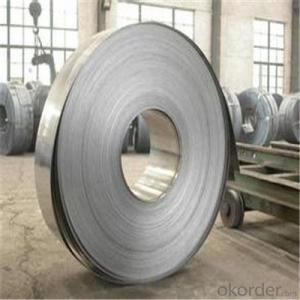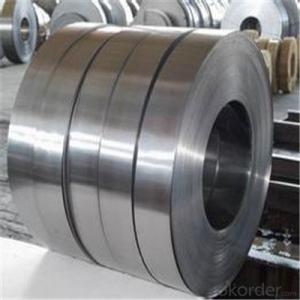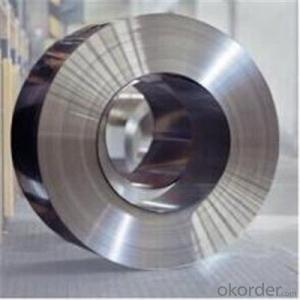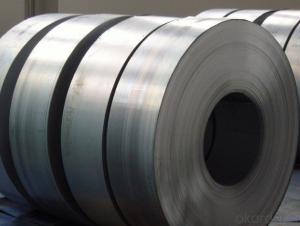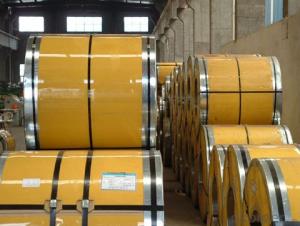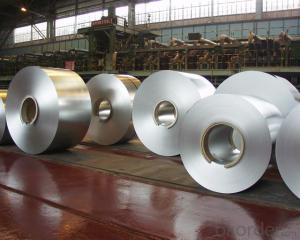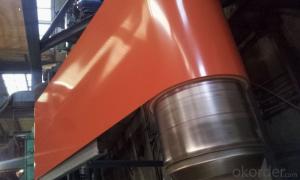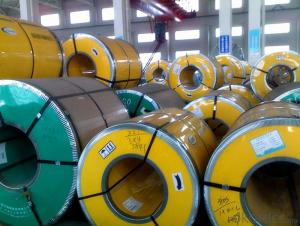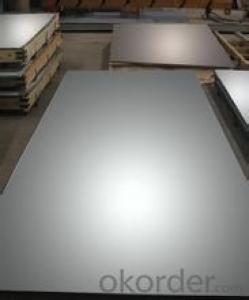Cold Rolled Galvanized Steel Strip Coils Q195 Q235 in China
- Loading Port:
- Qingdao
- Payment Terms:
- TT OR LC
- Min Order Qty:
- 44 m.t.
- Supply Capability:
- 22232332 m.t./month
OKorder Service Pledge
OKorder Financial Service
You Might Also Like
Item specifice
Applications of Steel Strip Coils:
1:Chemical industry equipment, Industrial tanks
2:Medical Instruments,Tableware, Kitchen utensil,kitchen ware
3:Architectural purpose, Milk & Food processing facilities
4:Hospital Equipment, interior Exterior decoration for building
5:Architectural purposes, escalators, kitchen ware,vehicles
Festures of Steel Strip Coils:
1. Each coil is closely covered by oil paper or plastic film.
2. Outside it is firmly packed with sack cloth or compound paper.
3. Steel strap or PP strap to pack the outside to ensure safety.
4. On/about 1000kgs to be packed with one wooden pallet.
5. Strips can be loaded to 20'FCL without pallet if required by customer.
6. LCL shipment can also be arranged once required by the customer.
Specifications of Steel Strip Coils:
| Standard | Galvanized Steel Coil Grade | Zinc Coating | Width | Thickness | Length | Capacity/Year |
| JIS G3302 | SGCH/SGCC-SGC570/SGHC-SGH340 | Z40-275g | 30-914mm | 0.3-4.0mm | Coil | 1,00,000Ton |
| EN 10346 | DX51D+Z/DX53D+Z/S220GD-S550GD | Z40-275g | 30-914mm | 0.3-4.0mm | Coil | 1,00,000Ton |
| ASTM A653 | CS-B/SS255-550 | Z40-275g | 30-914mm | 0.3-4.0mm | Coil | 1,00,000Ton |
Images of Steel Strip Coils:
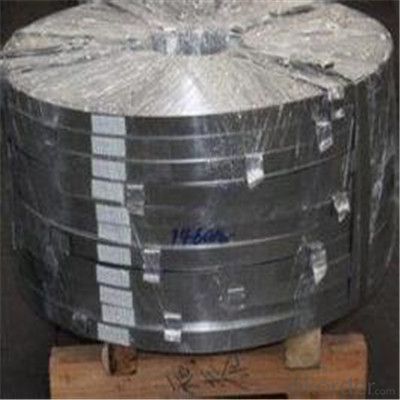
FAQ
1.What's your MOQ?
25MT, it is for one container.
2.Do you have QC teams?
Yeah, sure, our QC team is very important, they will keep the quality control for our products.
3. What's your normal delivery time?
Our delivery time about 10-20days for standard sizes, if you have other requirements like hardness and width ,it is about 20-40days.
- Q:Are steel strips suitable for the manufacturing of electrical transmission towers?
- Yes, steel strips are suitable for the manufacturing of electrical transmission towers. Steel has excellent strength and structural properties, making it an ideal material for constructing transmission towers that need to withstand heavy loads and adverse weather conditions. Steel strips can be easily processed and fabricated into the required shapes and sizes, ensuring the structural integrity and stability of the towers. Additionally, steel is highly durable and resistant to corrosion, which is important for the long-term reliability and maintenance of transmission towers.
- Q:What are the common surface treatments for steel strips?
- There are several common surface treatments for steel strips that are used to enhance their appearance, protect against corrosion, or improve their performance. These treatments include: 1. Hot-dip galvanizing: This process involves immersing the steel strip in a bath of molten zinc, which forms a protective coating on the surface. It provides excellent corrosion resistance and can extend the lifespan of the steel strip. 2. Electro-galvanizing: Similar to hot-dip galvanizing, this method involves applying a layer of zinc to the steel strip through an electrolytic process. It offers good corrosion resistance and is often used for thinner steel strips. 3. Electroplating: This treatment involves coating the steel strip with a thin layer of a different metal, such as chrome or nickel, through an electrochemical process. It can enhance the aesthetics of the steel strip and provide additional corrosion resistance. 4. Phosphating: This process involves treating the steel strip with a phosphoric acid solution, which converts the surface into a layer of phosphate crystals. Phosphating improves the adhesion of subsequent coatings and provides corrosion resistance. 5. Painting or powder coating: Applying a layer of paint or powder coating onto the surface of the steel strip can enhance its appearance, provide corrosion resistance, and improve durability. These coatings can be customized with various colors and finishes. 6. Passivation: This treatment involves treating the steel strip with an acid solution to remove impurities and create a passive oxide layer on the surface. Passivation improves corrosion resistance and is commonly used for stainless steel strips. 7. Pickling: This process involves immersing the steel strip in an acid solution to remove surface impurities, such as rust or scale. Pickling can improve the surface finish and prepare the steel strip for subsequent treatments or coatings. These surface treatments for steel strips are often chosen based on the desired level of corrosion resistance, appearance, and specific application requirements. Different industries and applications may require specific treatments to ensure the steel strips perform optimally in their intended use.
- Q:How are steel strips used in the railway industry?
- Steel strips are widely used in the railway industry for various purposes. One of the primary applications of steel strips is in the manufacturing of railway tracks. These strips are used to create the rails that form the track structure. The steel strips are typically hot-rolled and shaped into the desired rail profile, providing strength, durability, and stability to the track. Steel strips are also used in the construction of railway bridges and tunnels. They are often employed as reinforcement elements in the concrete structures, increasing their load-bearing capacity and structural integrity. Steel strips can also be used as tie plates, which are placed between the rail and the wooden ties to distribute the load evenly and prevent the rail from sinking into the ties. In addition to track and infrastructure applications, steel strips find their use in the manufacturing of various railway components. These include rail clips, fishplates, and fasteners. Rail clips are used to secure the rails to the sleepers, preventing lateral movement and maintaining the proper alignment of the track. Fishplates, also known as joint bars, are used to connect two rail sections together, ensuring a smooth transition between them. Fasteners, such as bolts and nuts, are utilized to secure the rail components tightly, maintaining the stability and safety of the track. Furthermore, steel strips are also employed in the fabrication of rolling stock components. They are used in the construction of railway wagons and locomotives, forming the structural framework and providing strength and rigidity to the vehicles. Steel strips are also used in the manufacturing of various interior and exterior parts, such as doors, panels, and frames. Overall, steel strips play a crucial role in the railway industry, providing the necessary strength, durability, and stability to the track, infrastructure, and rolling stock components. Their versatility and excellent mechanical properties make them an essential material for ensuring the safe and efficient operation of railways.
- Q:What are the cost considerations for using steel strips?
- The cost considerations for using steel strips include the price of the steel itself, the cost of transportation, any additional processing or fabrication required, and potential maintenance expenses. Additionally, factors such as market demand, availability, and fluctuations in steel prices can also impact the overall cost of using steel strips.
- Q:What are the transportation guidelines for steel strips?
- Transportation guidelines for steel strips typically include the following: 1. Packaging: Steel strips should be properly packaged to protect them from physical damage and corrosion during transportation. They are often packed in wooden crates or on wooden pallets, with appropriate padding and wrapping materials to prevent any movement or contact between strips. Additionally, securing the packages with straps or bands is essential to ensure stability and prevent any shifting during transit. 2. Loading and unloading: Steel strips are usually transported using trucks, railcars, or shipping containers. When loading or unloading, it is important to use appropriate lifting equipment, such as forklifts or cranes, to avoid any mishandling or damage to the strips. Care should be taken to distribute the load evenly and avoid overloading the transportation vehicle. 3. Stacking: When steel strips are stacked, they should be placed on a flat, level surface to prevent bending or warping. It is recommended to stack them in a way that allows for easy access and inspection, avoiding excessive pressure or weight on the bottom strips. 4. Environmental considerations: Steel strips should be protected from exposure to moisture, rain, snow, or extreme temperatures during transportation. This can be achieved by using weather-resistant coverings or tarpaulins and ensuring that the transportation vehicle is properly sealed and insulated. 5. Documentation: Proper documentation is essential for the transportation of steel strips. This includes accurate labeling of packages with relevant information, such as the type of steel, dimensions, weight, and any special handling instructions. Additionally, keeping records of the transportation process, including dates, times, and signatures, can help track and resolve any issues that may arise during transit. Following these transportation guidelines helps ensure that steel strips reach their destination in the expected condition, minimizing the risk of damage and ensuring customer satisfaction.
- Q:What are the main factors affecting the hardness of steel strips?
- The main factors affecting the hardness of steel strips are the carbon content, the alloying elements present, the heat treatment process, and the grain structure of the steel.
- Q:How are steel strips coated for corrosion resistance?
- Steel strips are coated for corrosion resistance through a process called galvanization. This involves immersing the steel strips in a bath of molten zinc, creating a protective layer on the surface of the steel. This zinc coating acts as a barrier, preventing oxygen and moisture from coming into contact with the steel and causing corrosion.
- Q:Can steel strips be customized in terms of thickness and width?
- Yes, steel strips can be customized in terms of both thickness and width according to specific requirements and applications.
- Q:Can steel strips be bent or formed into specific shapes?
- Steel strips have the capability to be bent or molded into specific shapes. They find extensive use in various industries due to their strength and versatility. To achieve this, a process known as cold working or cold forming is employed, eliminating the need for high temperatures. Essentially, pressure or force is applied to the steel strip, causing it to deform and adopt the desired shape. The elasticity of steel strips enables their utilization in construction, automotive, aerospace, and manufacturing sectors, where precise shapes and dimensions are imperative. Furthermore, steel strips can be subjected to heat treatment or annealing to further augment their malleability and capacity to maintain the desired shape.
- Q:How do steel strips perform in seismic conditions?
- Steel strips perform well in seismic conditions due to their high strength and ductility. The flexibility and resilience of steel enable it to absorb and dissipate seismic energy, reducing the impact on structures. Additionally, steel strips can be easily incorporated into the design of buildings to enhance their seismic resistance, making them a popular choice in earthquake-prone areas.
1. Manufacturer Overview |
|
|---|---|
| Location | |
| Year Established | |
| Annual Output Value | |
| Main Markets | |
| Company Certifications | |
2. Manufacturer Certificates |
|
|---|---|
| a) Certification Name | |
| Range | |
| Reference | |
| Validity Period | |
3. Manufacturer Capability |
|
|---|---|
| a)Trade Capacity | |
| Nearest Port | |
| Export Percentage | |
| No.of Employees in Trade Department | |
| Language Spoken: | |
| b)Factory Information | |
| Factory Size: | |
| No. of Production Lines | |
| Contract Manufacturing | |
| Product Price Range | |
Send your message to us
Cold Rolled Galvanized Steel Strip Coils Q195 Q235 in China
- Loading Port:
- Qingdao
- Payment Terms:
- TT OR LC
- Min Order Qty:
- 44 m.t.
- Supply Capability:
- 22232332 m.t./month
OKorder Service Pledge
OKorder Financial Service
Similar products
New products
Hot products
Related keywords
